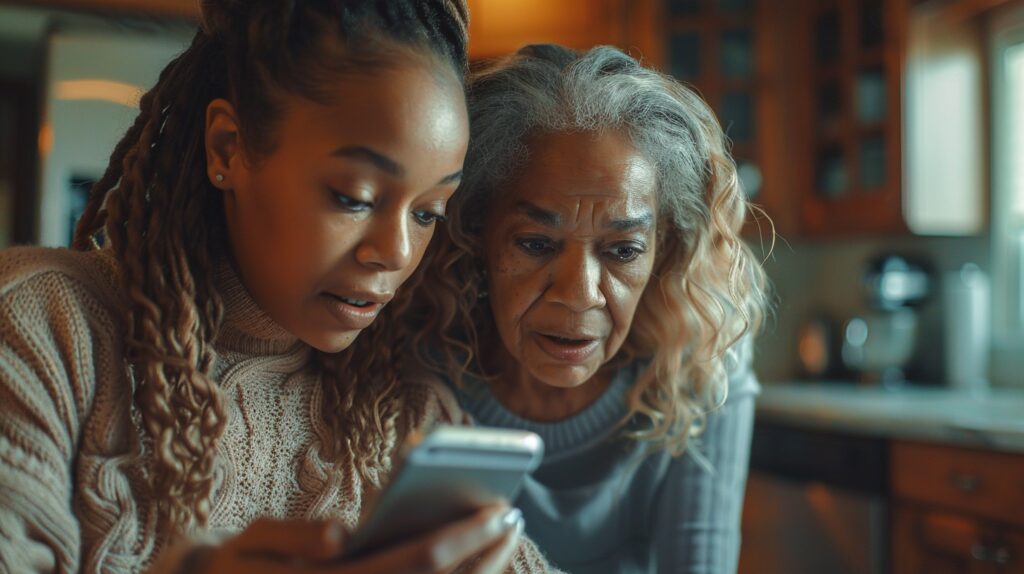Social Media Etiquette for Teenagers
As elders, it’s important to understand and guide our younger generation about the importance of social media etiquette. In this digital age, the concept of ‘social media etiquette for teenagers’ is more crucial than ever.
Why Social Media Etiquette Matters
Social media etiquette is not just about knowing what to post or not to post, it’s about respecting the rights and feelings of others in the digital world. Poor social media etiquette can lead to misunderstandings, hurt feelings, and in some cases, even serious consequences like cyberbullying or online harassment.
Just like offline etiquette, social media etiquette involves demonstrating respect and kindness to others. It’s a way of communicating appropriately according to the context and audience. By following proper social media behavior, teenagers can prevent misunderstandings and create a positive online environment.
The Impact of Your Online Presence
Your online presence can have a big impact on how others perceive you. Everything you post, share, or comment on social media contributes to your digital footprint. This can affect not only your personal relationships but also academic and career opportunities.
Many colleges and employers now check social media profiles of their prospective students or employees. A negative digital footprint can portray a poor image and can impact opportunities negatively. On the other hand, a positive digital footprint can open up new possibilities.
Teenagers need to understand that the internet never forgets. Even if you delete a post or a comment, it can still be accessible in some way. This is why it is vital to think before you post.
Teaching teens about the impact of their online presence and the importance of good social media etiquette can help them make informed decisions. For more information, check out our article on social media etiquette for students and social media dos and don’ts.
By understanding the importance of social media etiquette, teenagers can navigate the digital world with greater confidence and respect for others. As elders, let’s take the initiative to guide them through this journey.

Building a Positive Online Image
As elders guiding teenagers on their journey through the digital world, it’s essential to emphasize how to build a positive online image. This involves striking a balance between authenticity and oversharing, and creating engaging, respectful content.
Authenticity vs. Oversharing
When it comes to social media etiquette for teenagers, one of the most important lessons to teach is the difference between being authentic and oversharing. Encourage them to be genuine and true to themselves online. Authenticity fosters real connections and allows others to relate to them.
However, it’s just as essential to avoid oversharing. Personal thoughts, feelings, and experiences can make for engaging posts, but some things are better kept private. Oversharing can lead to issues like cyberbullying, identity theft, or damage to their online reputation. Discuss with them what types of information are appropriate to share online and what should be kept private. For more guidance on this, refer to our article on social media dos and don’ts.
Creating Engaging and Respectful Content
The content teenagers post on social media can greatly influence their online image. Teach them to create content that is both engaging and respectful. This means being mindful of their language, avoiding offensive or derogatory terms, and respecting the beliefs and opinions of others. They should also be encouraged to share content that is positive, uplifting, and provides value to others.
Remind them that the digital world is diverse, and what they post can be seen by people from all walks of life. They should strive to be respectful and considerate in all their online interactions. For more tips on creating respectful content, check out our article on proper social media behavior.
Building a positive online image is a crucial part of social media etiquette for teenagers. It not only enriches their online experience but also helps them develop essential digital skills. By being authentic without oversharing and creating engaging, respectful content, they can make a positive impact in the digital world. For more guidance on this topic, explore our articles on social media etiquette for students, social media etiquette tips, and social media etiquette guidelines.
Communication Etiquette
In the realm of social media etiquette for teenagers, communication plays a vital role. It’s not just about what you say, but how you say it that can shape your online interactions. Let’s delve into mindful posting and commenting, as well as handling conflict and criticism.
Mindful Posting and Commenting
Every time you post or comment online, you add to the conversation and your online image. It’s important to be mindful of the words you use, the tone you adopt, and the message you send out. With a few simple guidelines, you can foster a positive and respectful communication environment:
- Think before you post: Before hitting the send button, take a moment to review your message. Is it respectful, kind, and appropriate? If the answer is no, consider revising your message.
- Stay positive: Keeping your posts and comments positive can help create a supportive online environment. Negative or hurtful comments can harm relationships and damage your reputation.
- Respect others’ views: Everyone has the right to express their opinion. Agree to disagree respectfully when your views differ from others.
- Stay on topic: When commenting on posts, try to stay on topic. Off-topic comments can derail conversations and be seen as disruptive.
For more tips on mindful communication online, take a look at our social media etiquette tips.
Handling Conflict and Criticism
Conflict and criticism are inevitable parts of online communication. However, the way you handle these situations can make a significant difference.
- Do not engage in online arguments: If you find yourself in a disagreement, remember it’s always better to discuss sensitive topics in person. Online arguments can quickly escalate and cause unnecessary harm.
- Accept constructive criticism gracefully: If someone gives you constructive feedback, take it as an opportunity to learn and grow. Respond politely and thank them for their input.
- Ignore trolls: Some people may post offensive or provocative comments simply to cause trouble. Ignore these troll comments and avoid getting drawn into a fruitless argument.
- Report inappropriate content: If you come across any offensive, harmful, or inappropriate content, report it to the social media platform immediately.
Handling conflict and criticism maturely can help maintain a positive online atmosphere. For more guidance on this, explore our social media etiquette guidelines.
Practicing good communication etiquette online can help teenagers build a positive digital footprint and enjoy a more rewarding social media experience. It’s a key part of teaching our teens about the proper social media behavior and promoting healthier online interactions.

Privacy and Security
An essential facet of social media etiquette for teenagers revolves around privacy and security. It’s critical to be informed about these aspects to ensure a safe and respectful online experience.
Understanding Privacy Settings
The first step toward safeguarding your online presence is understanding privacy settings on various social media platforms. These tools allow you to control who can see your posts, profile information, and photos.
Each social media platform has its own set of privacy settings. Take time to explore these and adjust them according to your comfort level. For instance, you may choose to make your account private, allowing only approved followers to see your content. Alternatively, you may opt to keep your profile public but limit who can comment on your posts or share your content.
Remember, privacy settings can be changed at any time, so it’s a good idea to regularly review them to ensure they align with your desired level of privacy. Our article on social media etiquette guidelines offers more information on managing privacy settings effectively.
Being Cautious with Personal Information
Another crucial aspect of maintaining your privacy and security online is being cautious with personal information. This includes details such as your full name, contact information, home address, and school or work location.
You should avoid posting or sharing such information publicly on social media platforms. You never know who might be looking at your profile and what they might do with this information.
Additionally, be mindful of the information you share in private messages. Even if you trust the person you’re talking to, it’s always better to err on the side of caution and keep personal details to a minimum.
Remember, once something is shared online, it’s nearly impossible to completely erase it. A good rule of thumb is not to post anything you wouldn’t want everyone to see. For more tips on safeguarding your personal information online, check out our article on proper social media behavior.
By understanding privacy settings and being cautious with personal information, you can ensure a safer and more secure online experience. These practices form an integral part of social media etiquette for teenagers and can help you build a positive and secure digital footprint.
Etiquette in Interactions
In the world of social media, interaction is at the heart of the experience. How you respond to messages and notifications, and how you support and encourage others, form a critical part of your social media etiquette.
Responding to Messages and Notifications
As a teenager, you’ll likely receive various notifications and messages on your social media platforms. It’s important to respond to these in a timely and respectful manner. If a friend sends you a message, try to reply promptly. Ignoring or delaying responses can leave the other person feeling neglected or unimportant.
However, also understand the difference between urgent and non-urgent messages. For instance, a direct question or request might warrant a quicker response than a general comment on a post. Learn to prioritize and manage your responses effectively.
When responding, always be polite and respectful, regardless of the tone of the message you received. Remember, your response can be seen by others and contributes to your online image. For more on this, you can refer to our article on proper social media behavior.
Supporting and Encouraging Others
Being supportive and encouraging is another key aspect of social media etiquette for teenagers. Social media platforms provide a space for people to share their achievements, ideas, and experiences. As a part of this online community, show your support by liking, commenting, or sharing your friends’ posts.
Positive remarks and words of encouragement can go a long way in fostering a supportive online community. Remember to be genuine in your comments and avoid using generic responses.
You’ve probably seen how many people try to read between the invisible lines on Facebook.
However, avoid engaging in negative or hurtful comments. Even if you disagree with a post or comment, express your opinions respectfully and considerately. It’s possible to disagree without being disagreeable. For more guidance on this, check out our social media etiquette tips.
Your interactions on social media can have a significant impact on your online presence and the experiences of others. By responding to messages promptly, and by being supportive and encouraging, you can contribute to a positive and respectful social media environment.
Remember, the goal of social media is not only to share your life moments but also to uplift others and create a positive, interconnected community. For more on this, please read our guide on social media etiquette guidelines.
Reflecting on Your Digital Footprint
Your online actions leave a digital footprint that can impact your reputation and future opportunities. Understanding the importance of managing and learning from your digital experiences is a key aspect of social media etiquette for teenagers.
Managing Your Online Reputation
Managing your online reputation involves being mindful of what you post, share, and engage with on social media. Remember, what goes on the internet stays on the internet. Even if you delete a post or a comment, it’s possible that someone else may have already taken a screenshot or saved it.
To maintain a positive online image, consider the following:
- Think before you post: Is this something you would say or show in person? If not, it’s probably best not to post it online either.
- Stay positive: Negative comments or posts can come back to haunt you. Try to keep your social media interactions positive and respectful.
- Be respectful of others: Treat others the way you would like to be treated online. If you wouldn’t say something to someone’s face, don’t say it online.
- Keep private matters private: Not everything needs to be shared on social media. Keep personal information and private matters off the internet.
For more tips on managing your online reputation, check out our article on social media etiquette for students.
Learning and Growing from Digital Experiences
Social media is not just a platform for sharing and interacting with others; it’s also a place for learning and personal growth. Reflecting on your digital experiences can help you understand the impact of your online behavior and learn how to improve your social media etiquette.
Here are a few ways to learn from your digital experiences:
- Reflect on past interactions: Consider past interactions and think about what you could have done differently. Did you handle a conflict well? Could you have been more respectful in a conversation?
- Seek feedback: Don’t be afraid to ask for feedback from trusted friends or family members. They may have useful insights into how you can improve your online behavior.
- Learn from others: Observe how others behave online, especially those who seem to have a positive and respectful online presence. You can learn a lot from their actions.
- Be open to change: As you learn and grow, be ready to make changes in your online behavior. Remember, it’s never too late to improve your social media etiquette.
For more advice on learning from digital experiences, take a look at our article on proper social media behavior.
By managing your online reputation and learning from your digital experiences, you can improve your social media etiquette and create a positive digital footprint. Remember, every post, like, and comment contributes to your online image. Make sure they reflect the person you want to be. For further guidance, explore our social media etiquette tips.
